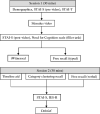The effects of immediate recall and subsequent retrieval strategy on eyewitness memory
- PMID: 36148393
- PMCID: PMC9487976
- DOI: 10.1080/13218719.2021.1976303
The effects of immediate recall and subsequent retrieval strategy on eyewitness memory
Abstract
The current study investigated the effects of immediate recall and subsequent interview on mock witnesses' memory of a crime. After watching a video of a crime, 111 participants were randomly allocated to an immediate recall condition (the iWitnessed mobile app, free recall). One week later, participants were randomly allocated to a retrieval condition (timeline aid, category clustering recall, free recall). Results showed that iWitnessed elicited more correct details than free recall at immediate recall (Time 1), without compromising accuracy. However, the immediate recall tool did not affect memory performance at a one-week delay (Time 2). At Time 2, participants with retrieval support (timeline aid, category clustering recall) reported more details than those with no retrieval support (free recall), without compromising accuracy. The findings highlight that high-quality immediate recall and retrieval support during a subsequent interview are necessary to elicit more complete and accurate accounts.
Keywords: Eyewitness memory; eyewitness recall; immediate recall; interviewing; retrieval strategy.
© 2021 The Australian and New Zealand Association of Psychiatry, Psychology and Law.
Figures
References
-
- American Psychiatric Association. (2000). Diagnostic and statistical manual of mental disorders. 4th ed., Text Revision). Author.
-
- Anderson, J. (1983). A spreading activation theory of memory. Journal of Verbal Learning and Verbal Behaviour, 22, 261–295. 10.1016/S0022-5371(83)90201-3 - DOI
-
- Areh, I. (2011). Gender-related differences in eyewitness testimony. Personality and Individual Differences, 50(5), 559–563. 10.1016/j.paid.2010.11.027 - DOI
-
- Beck, J. G., Palyo, S. A., Winer, E. H., Schwagler, B. E., & Ang, E. J. (2007). Virtual reality exposure therapy for PTSD symptoms after a road accident: An uncontrolled case series. Behavior Therapy, 38(1), 39–48 - PubMed
-
- Belli, R. F., & Al Baghal, T. (2016). Parallel associations and the structure of autobiographical knowledge. Journal of Applied Research in Memory and Cognition, 5(2), 150–157. 10.1016/j.jarmac.2016.03.004 - DOI
LinkOut - more resources
Full Text Sources

